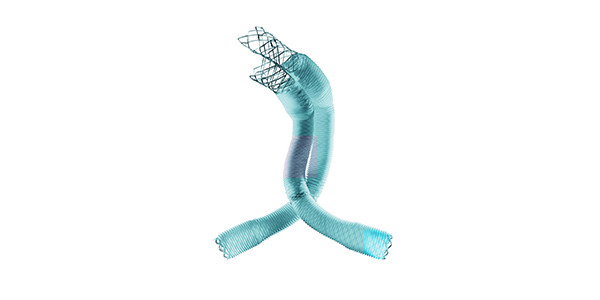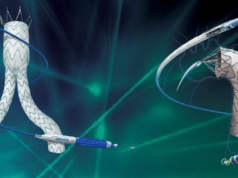
This article is an advertorial by Lombard Medical.
Endovascular repair presents a safe and effective treatment method, but late failure of endovascular aneurysm repair (EVAR) and endoleak both remain a problem for vascular specialists. A recent paper in the Journal of Vascular Surgery1 has reported an independent association between late mortality and AAA sac diameter increases, irrespective of endoleak, and more than 50% of patients with sac expansion had no identifiable endoleak. Deery et al concluded that sac expansion of at least 5mm at one year warrants potential early intervention. Vascular News speaks to Dainis Krievins (Pauls Stradins Clinical University Hospital, Riga, Latvia), David Murray (Manchester University, Manchester, UK) and Paul Hayes (Cambridge University Hospitals) about the causes for EVAR failure, and how the Altura endograft from Lombard Medical can help vascular surgeons to navigate some of these challenges.

Why might late EVAR failure occur?
Hayes: Aneurysm sac expansion post EVAR usually represents some form of treatment failure. We are fairly good at diagnosing type I and II endoleaks, but a large proportion of patients with post-EVAR sac expansion do not have an identifiable endoleak.
For me, I think there are more cases of device integrity failure than we recognise. Over five years, an EVAR graft is subjected to around 200 million cardiac cycles and it would be a great surprise if there is no loss of fabric integrity in at least some of the devices. We have treated cases in the past with no endoleak on a CT scan but an enlarging sac, that we have opened to explant and there are multiple small holes in the graft fabric, especially where sutures fix the fabric to the stent.
Murray: Late endograft failure can occur for a variety of different reasons related to aortic neck expansion or inadequate seal length and quality, iliac arteries length or dilation. or the aortic stent graft itself such as type III endoleak or limb dislocation.
Krievins: One reason for EVAR to fail is as a consequence of neck dilatation leading to endoleak or migration of the proximal end of the device. I believe the three most usual causes of neck dilatation include radial force from stent grafts, an underlying pathology of aneurysmal disease, and the presence of type II endoleaks which will pressurise the aneurysm and eventually, dilatation of the neck. Usually there is a component of all three causes when an EVAR fails.
Another reason for late EVAR failure is structural failure of the device, either by modular disconnection or by graft fabric damage; the classic type IIIa and IIIb endoleaks. Finally, a third reason for late EVAR failure is continued sac expansion without obvious endoleak— the so-called type V endoleak or “endotension”. As the cause for these failures is less specific, planning treatment can be more troublesome.

How does the Altura endograft meet these challenges?
Krievins: Altura is a dual lumen stent graft for its full length and therefore has no flow-divider. The endograft has recently been used to reline entire stent grafts and, where anatomy is appropriate, re-establish a juxta-renal seal zone. This means it can be possible to treat type I and type III endoleaks. When re-lining EVAR devices with other conventional EVAR implants, it is often difficult to fit a bifurcated device above the flow divider of the primary graft. The lack of a flow divider in Altura allows it to fit into short aortic bodies and maintain flow to both limbs. Other approaches might involve use of an aorto-uni-iliac graft with femoral to femoral crossover, which is probably a less attractive solution.
Murray: I am very much of the view that the design of the Altura stent graft lends itself to deployment in healthy aortic neck and should always be deployed with the IFU. This will allow a healthy aortic seal of up to 15mmm, which can be off-set to renal arteries, maximising aortic coverage. We have also deployed the Altura to reline previous failed historic stents with type III endoleak at the flow divider. In these cases, assuming there is no aortic neck dilation or migration, the Altura is an easy relining fix, particularly in previous aortic stents with a relatively short main body.
Hayes: Whether it is being used to extend a migrated EVAR proximally, or reline a failing graft, Altura has a great advantage over other devices in that its two D-shaped main bodies allow a bifurcated repair to be performed inside a short EVAR main body. I do not think there is currently another CE-marked device that can do this routinely without resorting to a uni-iliac and crossover solution. The retrograde deployment of the limb segment of Altura allows highly accurate placement at the iliac bifurcation if clinicians are trying to repair a type IB leak in a fairly short common iliac artery.

How does Altura compare to other endovascular stent grafts in this setting, and what factors may contribute to a lasting relevance in the EVAR treatment space?
Hayes: I think there are a couple of Altura features that are important in this regard. The first is the ability to reposition the proximal end of the device after initial deployment, enabling us to get a millimetre perfect placement each time. Secondly, the fact that the main body has been divided in two means that there has not needed to be any compromise on fabric thickness to achieve a low-profile solution. The fabric is the closest I have seen to our durable surgical grafts being used in an endovascular solution.
Krievins: Altura is currently the only available device that has two lumens for its entire length, and this is its primary advantage in this application. The delivery systems are 14F, which can aid access and the flexibility of the graft is also good. Altura also has long proximal bare stents with active fixation to resist distal migration.
Last year we published data on the primary use of Altura in the Journal of Endovascular Therapy, updating the evidence for the endograft with encouraging four-year results presented at VEITHsymposium last November. We still need to see greater quantities of data, which the company is now collecting in its registry.
Murray: We now have about 30 patients in our experience in Manchester that have been followed out to three years post implant. We have not noted any elective type I endoleaks and the aortic necks have been stable in diameter. Similarly, because of the bimodular system, we have not observed limb related dislocation. Furthermore, as the iliac deployment is retrograde allowing very accurate common iliac coverage, we have observed no type Ib endoleaks.
Can you tell us about a recent case of using Altura?
Krievins: Last year I held a workshop for future Altura users. On the morning of the workshop, we admitted a 78-year-old male patient with abdominal/back pain and hypotension. An emergent CT angiography scan confirmed the diagnosis of a ruptured abdominal aortic aneurysm, and we were able to use spare devices from our workshop to exclude this patient’s aneurysm under local anaesthesia. Sizing with Altura was helpful in this instance as there are only three proximal and three distal diameters to select between. The limbs ‘trombone’ within the aortic implants so the implant was adjusted to length on the table. The patient was discharged four days later and is doing well.
Hayes: The last case we treated was a patient with short, calcified iliac vessels. The iliacs were both less than 3cm in length and the retrograde deployment of the limb stents allowed us to use all of the available length as we landed within a couple of millimetres of the iliac bifurcation. The braided stent used in the Altura is useful in calcified vessels, and also those with tight aortic bifurcations, to help maintain patency. We have not seen a single limb occlusion so far in our Altura cases. I have been contemplating the value of Altura for CERAB type cases but as yet we have not used it in this role, although I am sure before long someone will.
Murray: I am always struck by the simplicity of the 14F Altura stent system, the quick procedure time, low contrast and radiation dose per case. However, the most striking clinical manifestation of this is the patients’ ability to recover and mobilise very early. We perform almost all Altura cases percutaneously now and the vast majority of cases are discharged at <24hrs. This has introduced the concept of day case EVAR, particularly for patients operated at the start of the list, for whom assuming local geography if favourable, are almost always ready to go later that evening if they wish.
References
1. Deery SE et al. Aneurysm sac expansion is independently associated with late mortality in patients treated with endovascalr aneurysm repair. J Vasc Surg 2018 January; 67(1): 157-164.













